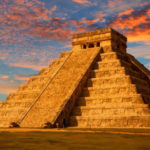Interesting facts about the federal republic of Mexico
 Mexico is a unique country. Spanish conquistadors, who once came to these lands, persistently planted their customs to the Indians, but despite this, the Mexicans managed to preserve their traditions. The culture of modern Mexico is an incredible mixture of European and Indian cultures, making this country one of the most unusual and original in the world.
Mexico is a unique country. Spanish conquistadors, who once came to these lands, persistently planted their customs to the Indians, but despite this, the Mexicans managed to preserve their traditions. The culture of modern Mexico is an incredible mixture of European and Indian cultures, making this country one of the most unusual and original in the world.
The first people appeared on the territory of modern Mexico at least to the twentieth millennium BC.
In ancient times, Mexico was inhabited by many powerful tribes, the most famous of which are the Aztecs and Mayans.
Mexico is one of the world’s largest oil exporters, while in the country oil refining is very poorly developed.
Traditional men’s headdress from Mexicans – sombrero. Although in reality the inhabitants of the country have long ceased to wear them, tourists annually buy thousands of sombrero as one of the main symbols of Mexico.
In early November, Mexico celebrates the Day of the Dead – Mexicans create home altars for their deceased relatives, who decorate with skulls of sugar, verbena, favorite dishes and drinks of the deceased. It is believed that on this day the souls of the dead return to their homes. In honor of the holiday there is a colorful carnival, and on the streets there are numerous trays with sweets in the form of skulls and skeletons dressed in women’s dresses.
In Mexico, the most popular folklore characters are the ghostly woman of La Joron (“The Weeping Woman”) and the mythical creature of Chupacabra, who kills livestock and sucks blood from it.
Mexican national sport – bullfight. Most likely, it here in its time “brought” the Spaniards.
Mexican cuisine is extremely sharp, as historically pepper and spicy spices have been used to preserve food.
The Mexican capital of Mexico City is the largest Spanish-speaking city in the world.
There are 10 archaeological parks on the territory of Mexico City. One of them was arranged around the Aztec pyramid, built in the XIV century.
Believers from all over the world come to Mexico City to see the main shrine of Latin America – a cloak with the image of the Holy Virgin of Guadalupe.
The Aztecs and many other tribes that inhabited the territory of Mexico did not disdain with cannibalism and prepared a ritual soup for the ambassador from the people. After the conquest of their empire by the Spanish, the Aztecs abandoned cannibalism and began to cook this soup of pork. Soup ambassador for this recipe is being prepared in Mexico and now.
In the Mexican recreation park Eco Alberto, there is an entertainment program, during which an illegal crossing of the American border is played out. Imaginary immigrants in the darkness of the night overcome a distance of 12 kilometers, moving through barbed wire, hiding from patrols and dodging bullets (fortunately, unmarried).
The descendants of the Maya, who live in the south of Mexico, prefer medical services to treatment with traditional rituals, which are conducted by shamans. An integral part of these rituals are alcohol and Coca-Cola – together they give a strong eructation, which is considered a sign of the release of the spirit of the disease from the body.
In Mexico, there is the only volcano on the planet, the beginning and the end of its growth were recorded by scientists. For 8 years the volcano Parikutin, which arose in the middle of the field of a local resident, reached a height of 424 meters.
Mexican general Antonio Lopez de Santa Anna, who in 1838 lost an ankle because of a battle wound, ordered to bury the amputated part of the leg with all the military honors assigned to him by rank.
In the city of Guanajuato there is a museum of mummies, numbering 111 exhibits. All the bodies represented in it were mummified in a natural way because of the peculiarities of the local climate.
In 2000, a Mexican peasant woman, who started labor, managed to successfully make herself a cesarean section using a kitchen knife, since the midwife lived 80 kilometers from her house. Both mother and newborn child survived.
Dogs of the Chihuahua breed got their name in honor of the Mexican state of Chihuahua, where this species was first discovered in the middle of the XIX century.
Mexican cuisine is an object of UNESCO’s world cultural heritage thanks to a variety of recipes that have been preserved since ancient times.



























